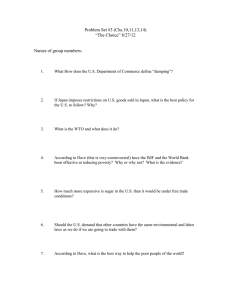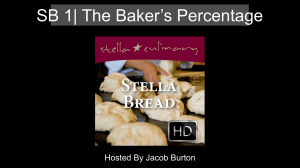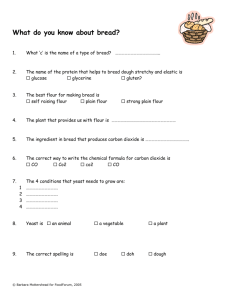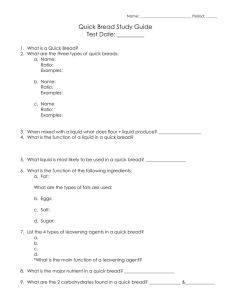-
advertisement
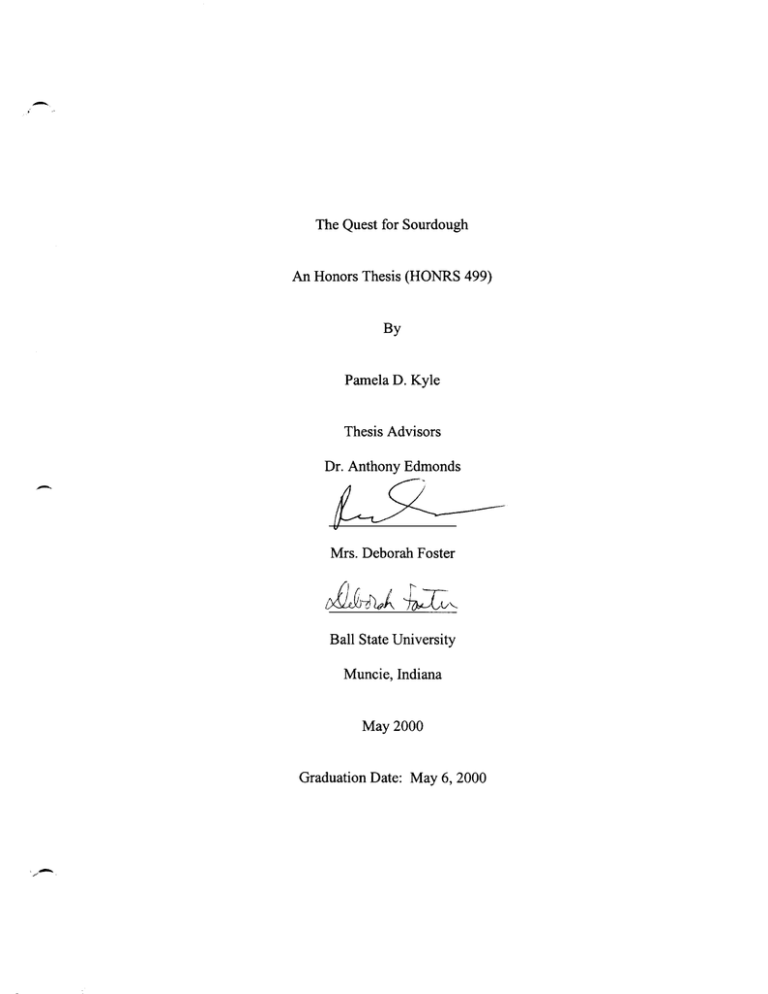
The Quest for Sourdough An Honors Thesis (HONRS 499) By Pamela D. Kyle Thesis Advisors - Dr. Anthony Edmonds ~ Mrs. Deborah Foster Ball State University Muncie, Indiana May 2000 Graduation Date: May 6, 2000 ./- - Acknowledgements - - I would like to thank both of my advisors for their help: Dr. Edmonds, who assisted me with the writing of the thesis, and Mrs. Foster, who helped me with my bread making. Thank you to my parents, who have always supported the odd ideas I come up with, and to my grandmother, for her cookbook contributions. Thank you to my roommate, who did not mind when I took over the kitchen table for weeks on end. And finally, thanks to the numerous taste testers, who benefited from the fruits of my labor! - Abstract The quest for sourdough begins with a discussion of the history of bread in general. The history begins with the first cultivation of grains and extends to present day. After discussing the history, I provide the results of my own experiments with sourdough bread. Finally, an appendix is given, outlining a possible demonstration of bread making. - - INTRODUCTION Bread. The staff of life. It can be a complicated mixture of grain, fats, and sugars, or as simple as flour, water, and salt. In any shape or form, it is an important part oflife. For many people, a meal is not complete without some form of bread or biscuit. To me, there are few sensations better than the smell and taste of fresh bread, especially when I have made it myself. Ever since a friend of my mother's taught me to make bread when I was 9, I've enjoyed the process of kneading and baking bread. In America, in the year 2000, most bread is mass produced, pre-sliced, and soH-crusted. When made at home, it's sometimes prepared using a bread - machine, but nearly always with the help of packaged yeast. Bakers did not always have commercialized yeast. For 5,000 years, fermented dough was used to raise bread. The bread that resulted from using fermented dough (or a "starter") is known today as sourdough. The most commonly known sourdough is San Francisco sourdough. Its tangy flavor is a delight to the palate. Even if not in California, sourdough bread can be an enjoyable change of pace from the everyday supermarket loaf. It is also more time consuming to make, as a sourdough starter must take at least a day to begin fermentation. A sponge is then made to ripen for several more hours before mixing and kneading the dough. A sourdough starter can also be difficult to maintain because the leavening action often depends on the atmosphere. Cooking expert James Beard feels that " .. .it is a most fickle process ... ; But for those who like a challenge ... " (70). - Being a Ball State Honors student, I accepted the challenge of making sourdough bread. Specifically, I tried to duplicate the famous San Francisco loaf. I made both old-fashioned (made without commercialized yeast) and yeast-enhanced starters to see in could prepare a loaf that does indeed taste like a sourdough. Before I began to bake, I first researched the history of bread. HISTORY OF BREAD "Food... [has] always served as an important aspect of cultural self definition" (Alves, 141). Necessary for survival and affected by our surroundings, food (or lack thereof) can make or break a society. For six millennia, the strength of nations depended on stock holds of wheat (Toussaint-Sarnat, 135). Grains were necessary to feed the populace and could be stored for a long time in case of wars and sieges. This support of civilizations would not have been possible if man had not learned to first plant and cultivate crops. Wild grasses took thousands of years to become grain-producing plants, and it was still a long time before humans learned to cultivate and eat the plants (Wood, 18). Agriculture began in the Neolithic Age, in and around the Fertile Crescent, the land between the Tigris and Euphrates rivers. According to Lothian, nomadic peoples ofthe Middle East were the first farmers, growing wheat, barley, and millet (5). An archaeological excavation in Jarmo, Iraq, found wild and domesticated wheat dating back to 8,000 BCE 2 - (Wood, 18). People in Syria and Palestine grew wheat and barley from 10,000 to 7,000 BCE, but these grains weren't much better than wild cereals (Toussaint-Samat, 126). The more manageable varieties of grains were grown in Jericho in 8,000 BCE) and also at the Neolithic site of <;atal Hiiyiik in Anatolia (Toussaint-Samat, 126, 132). At the site in Anatolia, the wheat found had six chromosomes, like modem wheat. In any case, early forms of grains were being planted, grown, and harvested by at least 3,000 BCE. The Dashur pyramid, built around 3,000 BCE, had husks and grains of wheat embedded in its bricks (Jacob, 15). In the - same time period as the Dashur construction, grains spread to Europe (Pomeranz and Shellenberger, 7). Wheat was common, but other grains spread throughout Europe as well. For example, buckwheat was established in Russia, rye in Scandinavia, and oats and barley in Scotland (Hensperger, 7). At first, those first cultivated grains were not used to make bread as we think of it. Paleolithic people parched grains to get rid of the husks (ToussaintSamat, 125). They then ate them like porridge or molded the grain into a flat cake and baked it on a rock. The first known reference to baked bread was made on a Sumerian clay tablet from 2,600 BCE (Casella, ix). The leavened product we consider to be bread today first appeared in Egypt around 4,000 years ago (Lothian,S). - According to a common myth, an Egyptian slave invented bread. He had left his flour and water mixture sitting out and noticed that it bubbled up 3 and smelled slightly sour. Not wanting to waste the dough, he added more flour and water and baked it. The resulting bread was much more palatable than previous items baked and became a core part of life. Hieroglyphics and loaves preserved in tombs show more than fifty different forms of bread (Lothian, 5). Ancient bakers were regarded as highly as priests and many temples contained ovens (Hensperger, 135). Besides being an important food, bread was a cultural unit and a unit of measure. Wages were paid in bread for centuries (Jacob, 31). From that practice came the correlation between "bread" and "money." Egyptians baked bread in two ways. They had dome shaped ovens and also used a charcoal method. Two conical clay pots set in charcoal pits were - used to create an environment perfect for baking the bread. After the pots were preheated in a fire, the dough was placed in the lower pot, with the second pot overturned and placed on top. In 1993, a team from National Geographic recreated an ancient bakery in Giza and made bread just as the ancient Egyptians did (Wood, 16). Egypt introduced leavened bread to Greece in the eighth century BCE (Pomeranz and Shellenberger, 2). Until this time, the Greeks had been using grains for porridges and flat cakes. In fact, a major part of the "democratic menu" in Sparta was a barley porridge (Toussaint-Samat, 137). After the introduction of raised bread, however, the Greeks became master bakers and even formed a church to honor it. The Bread Church of Eleusis worshipped 4 - Demeter (goddess of agriculture) and had ceremonies to honor the planting of autumn grains (Hensperger, 135). The Greeks invented "the true bread oven" (Toussaint-Samat, 224), one that could be preheated and opened in the front. By the fifth century BeE, Greece had commercial bakeries and offered many different kinds and shapes of bread (Pomeranz and Shellenberger, 2). This was very impressive for a country that had poor soil for wheat. Greece used their resources to produce and export olive oil, then imported grain. During the third century BeE, Athens imported 31,000 tons of wheat from Egypt, Syria, Libya, and Sicily (Pomeranz and Shellenberger, 7). -- The third century BeE also witnessed the decline of Greece and the rise of Rome. In 220 BeE, Rome aligned itself with a Greek league against Macedonia, who had been controlling Greece for a century. Twenty-three years later, the league and Rome successfully defeated the Macedonians. The Romans then dominated Greece from 146 BeD and in 27 BeE, Greece became a Roman province. Rome not only expanded to Greece, but also to Asia Minor, Northern Africa, Gaul, and England. It was a massive empire and, like all other empires, the people had to eat. According to Juvenal, "the populace longs eagerly for just two things-bread and circuses" (Lothian, 6). Rome's most important contribution to the history of bread was the - rotary mill. Before this device was invented, grain was pounded by hand into flour. With the rotary mill, two large circular stones were used to grind the 5 cereals into flour. Another rotary method was used to mix and knead dough with paddles in commercial bakeries. By Caesar Augustus' time, Rome had approximately 300 bakeries, each producing 2,000 loaves daily. (Lothian, 6) The majority ofthose bakeries were run by Greeks with assistants from Gaul (Toussaint-Sarnat, 227). For upper class Romans, the processes of those bakeries were very important. The flour had to be sifted finely, to remove as much ofthe bran as possible. This left fine flour to be used for making as white a loaf as possible. The elite favored white bread, as it kept them above the lower class and their coarse bread. To keep the upper class happy, chalk was sometimes added to the dough (Storck and Teague, 88). Also, bakeries had assistants wear gloves - and masks "so that no sweat or bad breath would spoil the dough" (Jacob, 77). To make that elegant bread, Rome had to have wheat. Like the Greeks, Rome mainly imported grain. Egypt was a large contributor to the Roman Empire, along with Spain, North Africa, Sicily, Sardinia, and England (Jacob, 83). Some men in Rome becarne very wealthy by keeping estates in Sicily and North Africa. The estates were quite prosperous until the fifth century CE, when the Roman Empire fell (Toussaint-Sarnat, 137). Rome had a lengthy decline through a series of poor emperors and attacks from the Visigoths and Vandals. By 500 CE, the Dark Ages had fallen across Europe. Historians have said that, during the Dark Ages, arts and culture were sustained through the church. The sarne was true for baking. - Many times the common people did not have a good harvest, but monasteries 6 - were generally able to harvest grain and make bread (Toussaint-Sarnat, 141). During the times of poor harvests, the populace occasionally reverted to gathering wild cereals. People in France even used chestnuts and acorns to make flour (Braudel, 112). When there were good harvests, however, the fine, white, all-wheat bread of the Romans was rare (Lothian, 6). It was reserved for the elite class. Maslin, a mixture of wheat and rye, was much more common to use in bread. There were two kinds of maslin: gray and black. Gray maslin, for the more privileged, had more wheat than rye, while black mas lin had more rye. Whether there was a good harvest or not, the diet of the poor was - always starch-based (Mintz, 75). Rye, buckwheat, oats, barley, and legumes made up a large part of meals. A note from 794 CE said bread was made from a mix of spelt, rye and wheat or groats, buckwheat, barley, and oats (pomeranz and Shellenberger, 3). Oat bread was for the poorest, since oats were considered fodder for horses. Milling and baking leavened bread in the Middle Ages were not done in the home. Instead, people took their grain to a miller, then took the flour to a baker. In 630 CE King Dagobert (lord of a Gaulish kingdom) made grinding a feudal right (Toussaint-Sarnat, 143). Bakers and private citizens had to take their cereal to a communal mill owned by the lord of the manor. This was a common practice throughout Europe. Millers did not own the mills; they rented them from the lord and collected a tithe for him. The millers usually 7 - ground flour for a fixed toll of one-sixteenth ofthe grain (Storck and Teague, 91). Water or wind powered the mills used. Some watermills in England date from the 700s and in Ireland from the eighth and ninth centuries (Toussaint-Sarnat, 143). Windmills did not enter the European landscape until the eleventh century when crusaders saw the devices on Crete and Greek islands. Throughout the Middle Ages, millers and bakers were not popular. Both were thought to be cheaters, holding back grain or stealing flour from the masses. Medieval poet Geoffrey Chaucer gives a good exarnple of millers' unpopularity in The Reeve's Tale. The poem is about a miller in Cambridge who is notorious for stealing flour and wheat, and so is despised by his customers. The poor especially hated bakers, seeing them as "profiteers and creators of hunger" (Carnporesi, 106). Shops were even attacked by mobs. In 1677, there was riot in the Casse district of Bologna, where vandals broke into a bakery and distributed flour to women and children (Carnporesi, 106). Why was there so much animosity toward millers and baker? In Europe, there was never an abundance of crops and were chronic shortages (Braudel, 112). The manufacturers of bread were hated more than others because bread was such a staple part of life. The French consumption of bread - in the 16th and 1i h centuries was 50%-70% of a worker's pay (Chelminski, 57) 8 - and a mason's farnily in Berlin spent 44.2% of their budget on bread (Braudel, 132). In France today, only 1% is spent on bread (Chelminski, 57). In 1492, Christopher Columbus landed in what would be known as the Americas. He started a great age of exploration and colonization. When people carne from Europe to begin a colony, they brought many supplies, including bread starters (Wood, 177). Colonial baking was a continuation of European conditions (Pomeranz and Shellenberger, 119). Baking was an important part oflife in the New World as it was in the old. Growing wheat was important as well. By the time of the Revolutionary War, wheat was the leading export of the Americas. Seventy-five tons of wheat carne from Mt. -- Vernon alone (Lothian, 6). For that reason, the 13 colonies were called the "Bread Colonies" for a time (Pomeranz and Shellenberger, 120). During the Revolutionary War, soldiers were given one pound of bread or flour for rations (Pomeranz and Shellenberger, 120). If flour was provided, soldiers occasionally pooled their flour together and traded it for baked bread at homes along their march. In 1778, a company of bakers with portable baking units was formed by order of Congress (Pomeranz and Shellenberger, 121). The hungry revolutionaries needed their bread! Portable baking units were only one of many developments from the 1700s to late 1800s. There was a population increase in Britain in the late 18 th century, which started their Agricultural Revolution (Toussaint-Sarnat, 150). - Agriculture began to be based more on scientific principles, rather than folklore. Four-course crop rotation brought "immediate profit and [enrichment 9 - to] the land" (Toussaint-Sarnat, 150). The new method, brought to England by Charles, 2nd Viscount Townshend, rotated wheat, clover, barley or oats, and root vegetables. There were also improvements in the milling process. Jacob Sulzburger created a method of grinding flour that transformed the milling industry. Instead of a millstone, iron rollers powered by steam crushed the grain. The "Hungarian" process, as it was known, ground wheat more rapidly and consistently. The resulting flour was whiter because the germ was completely removed from the endosperm and could be sifted off along with the other coarse particles. Also, since the germ spoiled quicker, the flour lasted - longer without it. The Hungarian process remained dominant in Europe until the World's Fair of 1873 (Jacob, 263). There, in Vienna, Americans tasted the products of the finely ground flour. Impressed, the American researched how the flour was made and took the idea across the Atlantic. It became firmly established on the Minnesota plains. That same decade, porcelain rollers were introduced (Tannahill, 374). They were easier to maintain than iron rollers and made roller milling standard. Edmund La Croix, a French immigrant, also made an important contribution to milling history in the 1870s. He developed a purifier that used air to remove the bran and germ from flour. Previously, sifters were used to - separate the wheat components. Inventor George T. Smith improved on La Croix's method by adding cleaning brushes to accompany the air currents 10 - (Storck and Teague, 212). This reduced the loss of pure flour being carried away with the other bits of wheat. The new methods to mill were better for not only soft wheat varieties, but also for hard wheat. Winter wheat in the North had been difficult to grind because it wore down millstones (Jacob, 350). Roller mills enabled the use of all types of flour, especially when hydraulic systems were used as a power source. Entrepreneur Charles Gaskill, in 1875, attached the first mill to the system powered by Niagara Falls. As bread historian H.E. Jacob puts it, "five million horses with white manes tossing in an electric dance could grind all the wheat in America" (350). - One of the hard wheats ground by the new methods came from Eastern Europe. In 1873, Mennonite Russian settlers brought a variety of wheat called Turkey Red to Kansas. This wheat "became the ancestor of all the winter wheat subsequently sown between the Atlantic and Pacific Oceans (ToussaintSamat, 151). As it was adaptable to little rainfall, Turkey Red also helped to make the fortune of the far West. The West in the 1800s was mainly a frontier, drawing people hungry for fertile soil, good grazing, and gold. The cattle drivers and gold prospectors were the ones who kept the art of sourdough alive. They still carried casks of starter on the trail to make their biscuits after other leavenings became available. By 1800, brewers' yeast was accessible to bakers. The yeast came from lager beer, a "bottom fermenter". This yeast didn't act as well as the "top - fermenters" previously distributed, so distillers began providing yeast. Their 11 - compressed yeast was soon being manufactured in factories all over central Europe. (Pomeranz and Shellenberger, 5) Amazingly, yeast was being manufactured without a lot of knowledge of what it was. Dutch microscopist Anton van Leeuwenhoek first identified yeast cells in the 17th century, but no research was done on it for 200 years. In the 1850s, Louis Pasteur, a French chemist, did the major study on yeast that gave us a great deal of knowledge we have today. After his work, methods for developing yeasts for bakers came rapidly. The compressed yeast sold throughout Europe was not available until 1867. That year, the Fleischmann brothers came to America from Austria. .- They were disappointed in the bread quality on a previous journey to the United States and wanted to improve it. They began selling baker's yeast in cakes across the country (Lothian, 6). Dry yeast was not available until 1945. It had been developed during WWII to provide bread for the armed forces. Other ways were found to raise bread, using pearl ash or baking soda. Pearlash is a potassium carbonate from wood ash. Developed in the 18th century, it became immensely popular as a quick leavener. By 1792, 8,000 tons of pearlash was exported from the United States. Baking soda, originally known as saleratus, was developed in England and sold throughout the Western world. In 1855, Preston and Merrill, a Boston company, combined soda with cream of tartar and sold it as baking powder (Lothian, 7). With all - these developments, sourdough became out of fashion and was considered a "primitive bread" by the late 19th century (Casella, 144). 12 - Whole-wheat bread could have been considered primitive and out of fashion for a time, too. The roller mills made flour naturally whiter, and many millers added oxidizing agents. The agents bleached the flour and helped to preserve it. In the 1850s, most white flour in England was found to contain alum (Tannahill, 346)! The use of alum was quickly banned, but other, safer ways have been found to bleach flour. Nitrogen peroxide was common at the tum ofthe century. Today, potassium bromate, potassium iodate, chlorine dioxide, and azodicarbonate are used (Pomeranz and Shellenberger, 224). Other items added to flour and bread today are vitamins. Most of the nutrition in wheat is in the bran and germ. Since white flour contains neither, people can suffer vitamin deficiencies without enrichment of some sort. - The relationship between nutrition and whole wheat had been suspected ever since roller mills became popular. There were many cases that showed links between whole grains and health. One such case involved a WWI ship, the Kronprinz Wi/hem. The Kronprinz was a German navy cruiser that attacked 13 ships before the crew became ill. The ship docked in the United States in April 1915, after twenty percent of the men aboard died. (Elkort, 127). At first, the doctors who inspected the crew eliminated beriberi as a cause of the deaths. Beriberi is a disease caused by a deficiency of thiamin (or vitamin BI)' The crew had plenty of food, so the doctors didn't believe they had a lack of nourishment. A reporter named Al McCann thought differently. ,- He saw that the ship had great quantities of food, but little variety. Tinned 13 - meat, sausages, cheeses, biscuits, and white flour were prevalent, but no whole-wheat flour. McCann recommended a diet for the crew that included water soaked in wheat germ and bran. The men were cured within weeks. (Elkort, 128) Several more years were spent researching the link between wheat and nutrition before bread was fortified. British millers added thiamin to their flour in 1939. In 1940, "Practically the entire American milling and baking industry embarked on an enrichment program" (Storck and Teague, 305). Soon after, enrichment specification set by government required certain amounts of thiamin, niacin, riboflavin, and iron. Fortified bread was available because - there were few people interested in 100% whole wheat, which is healthier (Pomeranz and Shellenberger, 122). Since 1945, "We seem to be on the way towards a synthetic conveyorbelt bread make by robots in computer programmed industrial bakeries" (Toussaint-Samat,242). Ever since pre-sliced bread appeared in 1925, convenience has been key (Harbison, 67). Many people pay no attention to the loaf they take off the shelf. However, there are plenty that still enjoy eating and baking hearty loaves. Italians are an excellent example of bread lovers. Many industrial bakeries were built in Italy in the 1950s and 60s. Identical loaves of bread were produced, quite unlike the ancient Roman bread that had character. But "organizations were formed to preserve the breads ofthe past, schools - taught the old recipes, and lecturers touted the glories of fresh bread" (Elkort, 151). The traditional breads returned to Italy. 14 - In the United States, a Japanese invention has encouraged more people to join the group of bread devotees. The invention is the automatic bread machine. Bread machines can mix, knead, and bake bread at the touch of a button. Not only is bread making much quicker, but people can once again relish the smell of fresh baked bread. The bread machine's convenience has made it very popular in the 1990s. And as for the future? The story of bread is far from complete. Old World breads will remain popular and new ways will be found to improve the daily loaf. Bread will have an enduring place in our lives. In bread production, loaves may be handmade, though convenience will still be a key factor. The fast-paced world will make sure ofthat. But there will always be bread aficionados: those souls like myself who find pleasure in the creation of the food of the ages. MY SOURDOUGH EXPERIMENT My goal in baking bread with a starter was to produce a loaf that did taste like a sourdough as we think of it in modem times--the tangy San Francisco bread. I feel the same way as cookbook author Dolores Casella: "In modem times ... sourdough rightly belongs to the Far West (143)." However, in my research, I found that a sourdough is highly dependent on the atmosphere and wild yeasts of the region it is made in. Observing the differences between San Francisco and Muncie, Indiana, it is not hard to foresee the difficulties in making a similar tasting loaf in the Midwest. I 15 - decided to accept the challenge anyway, and made several starters throughout the spring of 2000. I tried a raw potato starter, a beer starter, and two yeastenhanced starters. The first starter came from Breads, a Time-Life book. Called Modem Sourdough Starter, it included flour, active dry yeast, and water. The ingredients were mixed and left in a warm place for 24 hours. Once the starter was frothy, I made the book's accompanying recipe, Sourdough Bread (or Pain au Levain). The result was nutty-flavored bread with a chewy crust and unifonn interior. I next made a raw potato starter from Ada Lou Robert's Breads and Coffee Cakes with Homemade Starters. To make it, I combined water, flour, salt, sugar, and one grated raw potato. The mixture, left out on my kitchen counter for three days, went through interesting stages. It was white in the beginning, changed to gray, then went back to white as it matured in the refrigerator for a week. As intriguing as the color changes were, the bread (Basic Starter Bread) was even more so. The potato imparted a sweet flavor to the bread. It was similar to an egg bread, but without the richness. Of all the loaves I made, this was my favorite. I began a beer starter third, using Robert's book again. It used potatoes, water, cornmeal, sugar, salt, and the foam from a 12-ounce can of chilled beer. Unfortunately, this starter did not ripen as it should have. A half- - inch of liquid needed to rise to the top of the mixture, which never occurred. 16 - From Dolores Casella's book, A World of Breads, I made Sourdough French Bread. The sourdough in this loafwas from a yeast starter, consisting of yeast, water, flour, and sugar. This mixture was left out for only two days before it could be used. The bread, like the raw potato starter bread, was slightly sweet. As a starter matures, its flavor sometimes changes. To find out if this was true, I made another batch of bread using the raw potato starter. The starter had been stored in a glass jar in my refrigerator for three weeks. The bread did not taste different than my first attempt, but it must be taken into consideration that three weeks isn't very long. There are some sourdoughs that - are decades old ("Man nurtures ... " 3D). Each of the loaves I made tasted good but did not have a flavor as I had hoped. I did want to create bread with a sour flavor. However, the Indiana atmosphere was indeed too different from the California environment to attain that characteristic. There are possible modifications for the bread to make it tangier. I could have added yogurt, buttermilk, or beer in place of some ofthe liquid. There is also a product available called Sourdough Enhancer that can be added to the dough. Any ofthese additions would help a baker give bread an acidic flavor. If you want true San Francisco sourdough bread, though, I have come to only one conclusion: Head West! 17 - APPENDIX Because of time constraints, I was not able to make a presentation on my findings, as I would have like. In had been able to do a demonstration, I would have spoken about the history of bread and shown the process of making sourdough bread in the following format: - I. The Starter II. The Sponge III. The Dough IV. Kneading V. Proofing VI. Shaping VII. Baking I. A starter can be made in several ways. Flour and water is the simplest. They are mixed together and set outdoors to capture the wild yeasts. Potatoes (cooked or raw), potato cooking water, milk, sugar, beer, and commercial yeast can also be added to modify the mix and give it a more unique flavor. The different ingredients also affect how well the sourdough will work. Yeast feeds on sugar, so that addition could make the culture act quicker. Commercial yeast makes the most stable starter because the dependency on wild yeast is eliminated. 18 - The ingredients called for in the recipe are combined and placed in a glass or pottery container. After sitting out in a warm, draft-free place, the sourdough can be used for the recipe. However, some recipes call for the starter to be placed in the refrigerator until it "ripens." That is, a half-inch of liquid needs to rise to the top of the mixture before it is used. II. The sponge is made by taking the sourdough and adding more flour and water. This is left out for 12 to 24 hours, then divided in two. Half is used for the recipe and the rest is left for the next time bread is baked. -. III. The starter is joined with the rest of the ingredients. Flour, yeast, and a liquid are the ingredients common to every recipe. Other items can be added to change the taste. Eggs and butter, for example, make a richer bread. IV. The method I use to knead bread was taught to me when I was 9. After placing the dough on a floured board, I flour my hands and used a 3-step method. I push the dough forward, fold the front half over the back, turn it one quarter, then repeat. Each loaf of bread will take a different amount of time, but the average is 8 to 10 minutes. Kneading is finished when the dough is smooth, elastic, and springs back after being pushed with a finger. 19 - V. Proofing, or rising, can be induced in as many different ways as there are recipes. The dough, placed in a bowl and covered, can be put into an oven with the light on. The oven can also be turned on to 200 0 F for 1 minute, then shut off, before the dough is placed inside. Other suggestions are to put the dough on top of the refrigerator, inside a Styrofoam box, or over a pan of hot water. Any place, so long as it is warm (80 to 90) and draft free, is suitable. This step is generally done twice--once before shaping and once afterward. Proofing is finished when an indentation stays in the dough after it is pressed with a finger . .- VI. The dough can be put into many different forms. I find round loaves the easiest, as you can just tum the dough out of the bowl and have a perfectly shaped loaf. Other shapes include long loaves (or baguettes), ovals (boules), other stuff. Pans are helpful if one wants to make sandwich bread. VII. After shaping, the bread is placed in a preheated oven. The amount of time and the degree depends on the recipe. The bread is done when it sounds hollow after being tapped on the bottom. Enjoy! 20 - BIBLIOGRAPHY Alves, Abel A. Brutality and Benevolence. Connecticut: Greenwood Press, 1996. Beard, James. Beard on Bread. New York: Alfred A. Knopf, Inc, 1973. Braudel, Fernand. The Structure ofEveryday Life. Vol. Iof Civilization and Capitalism 15th _18th Century. Trans. SHill Reynolds. New York: Harper & Row, 1981. Camporesi, Piero. Bread of Dreams. Trans. David Gentilcore. Chicago: The University of Chicago Press, 1989. Casella, Dolores. A World ofBreads. New York: David White Company, 1966. Chelminski, Rudolph. "Anyway you slice it, a PoiHille loaf is real French bread." Smithsonian. January 1995: 51-58. Elkort, Martin. The Secret Life ofFood: A Feast ofFood and Drink History, Folklore, and Fact. Los Angeles: Jeremy P. Tarcher, Inc., 1991. Harbison, Elizabeth M. Loaves ofFun. Chicago: Chicago Review Press, 1997. Hensperger, Beth. Baking Bread: Old and New Traditions. San Francisco: Chronicle Books, 1992. Jacob, H.E. Six Thousand Years ofBread. Trans. Richard and Clara Winston. New York: Doubleday, Doran and Company, Inc, 1944. Lothian, Alan, ed. Breads. Alexandria, Virginia: Time-Life Books, 1981. "Man nurtures his starter of sourdough for decades." The Star Press. 2 March 2000: 3D. Mintz, Sidney W. Sweetness and Power. New York: Viking, 1985. Pomeranz, Yeshajahu and lA. Shellenberger. Bread Science and Technology. Connecticut: The Avi Publishing Company, Inc, 1971. Storck, John and Walter Darwin Teague. Flour for Man's Bread. Minneapolis: University of Minnesota Press, 1952. 21 Tannahill, Reay. Food in History. New York: Stein and Day, 1973. Toussaint-Sarnat, Maguelonne. A History ofFood. Trans. Anthea Bell. Carnbridge, Massachusetts: Blackwell Publishers, 1992. Wood, Ed. World Sourdoughs from Antiquity. Berkley, California: Ten Speed Press, 1996. - ,-, 22


